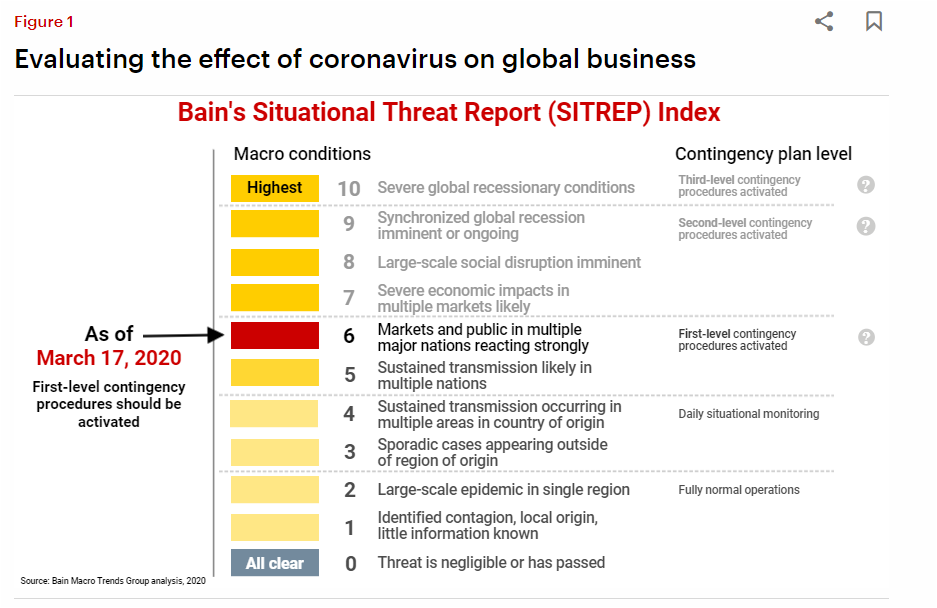Defending Consumer Products Companies against COVID-19
Data: 2020 m. kovo 24 d.

This defining leadership moment is an opportunity to strengthen companies for the long term.
- An operational checklist to help consumer goods companies frame their immediate response to the COVID-19 pandemic and their planning for an eventual recovery and beyond.
- Key actions include empowering your emergency response team, reviewing and adapting production plans, turbocharging logistics flexibility and adjusting commercial strategy.
The crisis is a defining leadership moment in consumer products. Above all, the safety of employees, customers and business partners will remain paramount.
- The COVID-19 viral disease has now evolved from a looming threat to a real and present danger for consumers and companies alike. With nearly 120,000 people infected across at least 114 countries as of March 11, the World Health Organization has officially classified the disease as a pandemic.
Bain & Company’s Situational Threat Report Index, which combines official data with our own modeling, is continuing to evaluate COVID-19’s effect on global business, grading it from 0 (a negligible threat) to 10 (severe global recessionary conditions). As of March 12, the index stood at 6, with sustained transmission likely in multiple nations (see Figure 1).

At that level of threat, businesses should be enacting first-level (in a three-tier plan) contingency procedures. This may include deferring nonstrategic investments and activities and adjusting capacity plans, consistent with an imminent recession of modest scale and short duration. Travel across national borders should be carefully monitored or minimized to avoid stranding travelers due to quarantines; substitute in-market staff wherever possible.
In the geographies that have been affected, consumer products companies are feeling intense tension and operational stress. Few business leaders can hope to predict the course of the pandemic with any accuracy. However, consumer products companies need to quickly roll out contingency plans to address the crisis head-on and ensure business continuity, while playing their role in minimizing the spread of the virus.
While the level of disruption will vary across geographies and companies, we have developed the following operational checklist to help consumer products executives assess their exposure and take rapid action, while planning for an uncertain future.
Lessons from China, Italy and other impacted regions
Bain’s leading position in both the Chinese and Italian consumer products industries has armed us to quickly assess the impact on CPGs as the COVID-19 situation unfolds. We’ve identified several features of the crisis that are likely to affect consumer products companies in other countries as the virus expands globally.
Perhaps the biggest factor is a company’s product category. It is now well known that in areas affected by the virus, consumers have hoarded necessities and key pantry and household items (such as disease-prevention products and packaged, shelf-stable food) while reducing consumption of nonessentials (see Figure 2). Based on our observations in China and beyond, four main category archetypes have emerged as the disease has spread:
- Panic-buying of disaster-preparedness categories, such as disinfectants, masks, hand sanitizer, instant meals and medical supplies. There has been a huge spike in demand for these categories, with products rapidly undersupplied across channels―resulting in extremely tight turnover and frequent out-of-stocks.
- Pantry-loading of daily essentials, such as infant food and formula, shelf-stable groceries, daily hygiene products, and bottled water. These products face constrained supply and below-average stock levels.
- Short-term declines in household discretionary products, such as traditional dairy, soft drinks, snack foods, personal care and pet care.
- Intense declines in nonessentials and luxury products, such as cosmetics, luxury beauty and skin care, confectionary, and alcoholic beverages. Demand for these categories has rapidly collapsed, especially in alcoholic beverages, which faces the additional headwind of heavy reliance on on-trade sales (subject to temporary closures and social-distancing measures).
- Read full brief: BAIN & COMPANY

